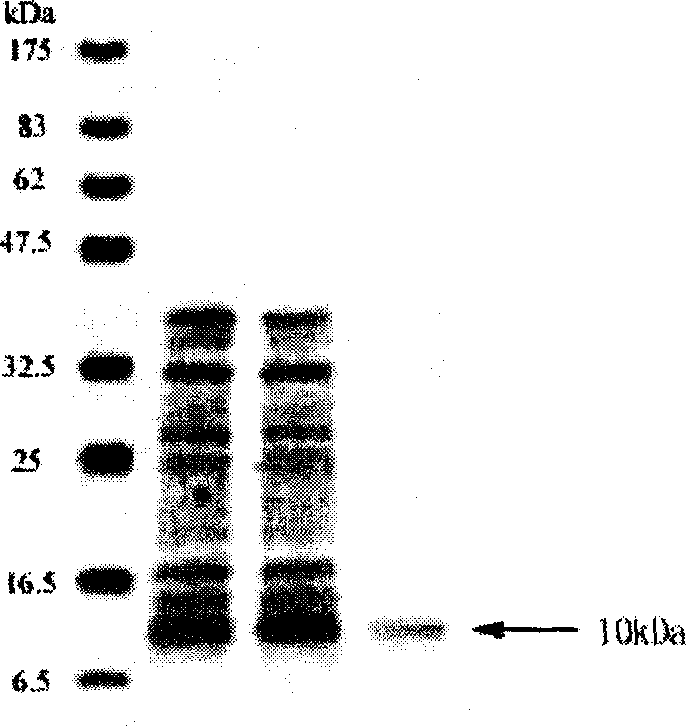Polypeptide-human protein containing linking protein family characteristic sequential fragment-9.68 and polynucleotide for encoding it
A polynucleotide and protein family technology, applied in peptide/protein components, anti-animal/human immunoglobulin, DNA/RNA fragments, etc., can solve related protein expression and function abnormalities, metabolic or developmental disorders, etc. question
- Summary
- Abstract
- Description
- Claims
- Application Information
AI Technical Summary
Problems solved by technology
Method used
Image
Examples
Embodiment 1
[0144] Total RNA was extracted from human fetal brain by one-step method of guanidine isothiocyanate / phenol / chloroform. Poly(A) mRNA was isolated from total RNA using Quik mRNA Isolation Kit (product of Qiegene). 2ug poly(A) mRNA was reverse transcribed to form cDNA. Smart cDNA cloning kit (purchased from Clontech) was used to insert the cDNA fragment into the multiple cloning site of the pBSK(+) vector (product of Clontech Company), transform DH5α, and the bacteria formed a cDNA library. The sequences of the 5' and 3' ends of all clones were determined using Dyeterminate cycle reaction sequencing kit (product of Perkin-Elmer) and ABI 377 automatic sequencer (Perkin-Elmer). Comparing the determined cDNA sequence with the existing public DNA sequence database (Genebank), it was found that the cDNA sequence of one of the clones, 1722c11, was a new DNA. The insert cDNA fragment contained in this clone was determined bidirectionally by synthesizing a series of primers. The resu...
Embodiment 2
[0144] Total RNA was extracted from human fetal brain by one-step method of guanidine isothiocyanate / phenol / chloroform. Poly(A) mRNA was isolated from total RNA using Quik mRNA Isolation Kit (product of Qiegene). 2ug poly(A) mRNA was reverse transcribed to form cDNA. Smart cDNA cloning kit (purchased from Clontech) was used to insert the cDNA fragment into the multiple cloning site of the pBSK(+) vector (product of Clontech Company), transform DH5α, and the bacteria formed a cDNA library. The sequences of the 5' and 3' ends of all clones were determined using Dyeterminate cycle reaction sequencing kit (product of Perkin-Elmer) and ABI 377 automatic sequencer (Perkin-Elmer). Comparing the determined cDNA sequence with the existing public DNA sequence database (Genebank), it was found that the cDNA sequence of one of the clones, 1722c11, was a new DNA. The insert cDNA fragment contained in this clone was determined bidirectionally by synthesizing a series of primers. The resu...
Embodiment 3
[0146] The human protein-9.68 containing the characteristic sequence fragment of the connexin family of the present invention has homology with the MOTIF domain, the homology result is shown in Figure 1, the homology rate is 20%, the score is 10.69; the threshold is 10.85. Example 3: Cloning the gene encoding human protein-9.68 containing the characteristic sequence fragment of the connexin family by RT-PCR
[0147] The total RNA of fetal brain cells was used as a template, and oligo-dT was used as a primer to carry out reverse transcription reaction to synthesize cDNA. After purification with a Qiagene kit, PCR amplification was performed with the following primers:
[0148] Primer1: 5'-CATCCTGAGAACTGAAATTGATCGC-3'(3)
[0149]Primer2: 5'-ATAAAATTTTTGAATTTATGTTCAA-3'(4)
[0150] Primer1 is the forward sequence starting from the 1bp at the 5' end of 1;
[0151] Primer2 is the 3' reverse sequence in 1.
[0152] The conditions of the amplification reaction: 50mmol / L KCl, 10mmo...
PUM
 Login to View More
Login to View More Abstract
Description
Claims
Application Information
 Login to View More
Login to View More - R&D
- Intellectual Property
- Life Sciences
- Materials
- Tech Scout
- Unparalleled Data Quality
- Higher Quality Content
- 60% Fewer Hallucinations
Browse by: Latest US Patents, China's latest patents, Technical Efficacy Thesaurus, Application Domain, Technology Topic, Popular Technical Reports.
© 2025 PatSnap. All rights reserved.Legal|Privacy policy|Modern Slavery Act Transparency Statement|Sitemap|About US| Contact US: help@patsnap.com



